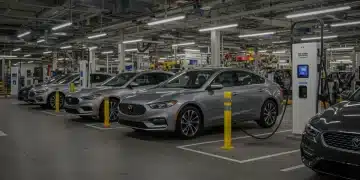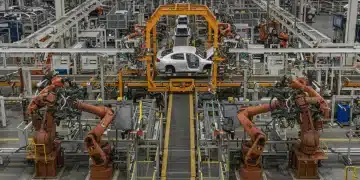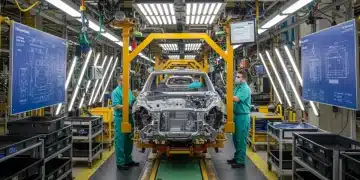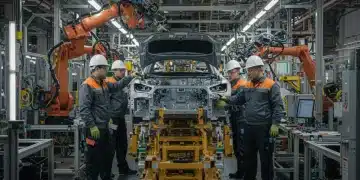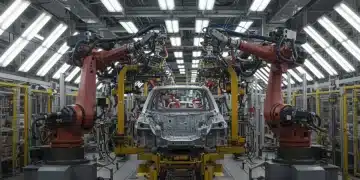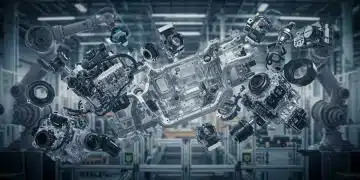US Government Incentives Reshape Q2 2025 EV Landscape
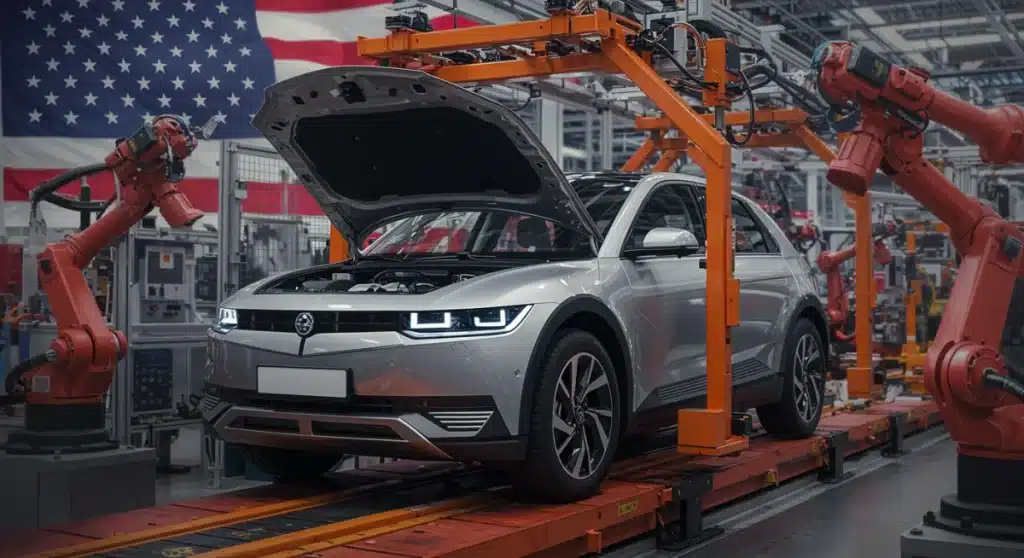
As Q2 2025 unfolds, the question of How US Government Incentives for EV Production are Shaping the Q2 2025 Automotive Landscape remains central to industry discussions and consumer decisions. These strategic incentives are not merely influencing, but actively transforming, the trajectory of electric vehicle manufacturing and adoption across the nation.
The Inflation Reduction Act’s Enduring Impact
The Inflation Reduction Act (IRA), signed into law in August 2022, continues to be a pivotal force in the US electric vehicle (EV) market. As of Q2 2025, its provisions are deeply embedded in the automotive industry’s strategic planning and operational execution, particularly concerning domestic production and supply chain resilience. The IRA’s tax credits for consumers purchasing new and used EVs, coupled with manufacturing incentives, are directly influencing where and how EVs and their components are made.
Manufacturers are aggressively re-evaluating their supply chains and production footprints to qualify for these substantial benefits. This has led to a noticeable surge in domestic investment, fostering a more robust and self-reliant EV ecosystem within the United States. The ripple effect is evident in new factory announcements, expanded facilities, and a renewed focus on American-made components.
Consumer Tax Credits and Eligibility
The consumer tax credits, offering up to $7,500 for new EVs and $4,000 for used EVs, are subject to stringent eligibility requirements that continue to evolve. These requirements, particularly concerning battery component sourcing and critical mineral extraction, are driving significant changes in manufacturing strategies.
- New EV Credit: Vehicles must meet specific battery component and critical mineral sourcing thresholds from North America or free-trade agreement countries.
- Used EV Credit: Available for vehicles purchased from a dealer for $25,000 or less, at least two model years old, and meeting certain battery requirements.
- Income Limitations: Both new and used credits have adjusted gross income limitations for buyers, ensuring the incentives target a broad consumer base.
Domestic Manufacturing Surge and Job Creation
The promise of significant federal funding and tax incentives has catalyzed an unprecedented surge in domestic manufacturing investment. Automakers and battery producers are pouring billions into new facilities and expanding existing ones across states like Georgia, Michigan, and Tennessee. This investment spree is directly tied to the IRA’s stipulations for local content and production, aiming to reduce reliance on foreign supply chains.
This localized production strategy is not only about meeting qualification criteria for incentives but also about creating a resilient and innovative domestic industry. The focus on onshore manufacturing is generating thousands of new jobs, from highly skilled engineering roles to assembly line positions, providing a substantial economic boost to various regions.
Key Investment Hotspots and New Facilities
Several states have emerged as key players in this manufacturing boom, attracting major investments due to strategic locations, available workforce, and existing infrastructure. These regions are becoming hubs for the entire EV supply chain, from raw material processing to final vehicle assembly.
- Georgia: Home to new battery plants and assembly facilities, benefiting from state-level incentives complementing federal programs.
- Michigan: Leveraging its automotive heritage, the state is seeing significant retooling and new investments in EV production and battery manufacturing.
- Tennessee: A growing hub for EV assembly and battery production, attracting companies with favorable business environments.
Supply Chain Reconfiguration and Critical Minerals
A critical aspect of the IRA’s impact is the imperative to reconfigure EV supply chains, particularly concerning critical minerals. The incentives are pushing manufacturers to secure minerals from North America or countries with free-trade agreements with the U.S., significantly reducing dependence on traditional, often geopolitically sensitive, sources. This strategic shift is designed to enhance national security and economic stability while ensuring a steady supply of essential materials for EV battery production.
Companies are actively exploring new mining opportunities, developing advanced recycling technologies, and forging partnerships to build a robust, localized supply chain. This reorientation is a complex process, requiring substantial investment in infrastructure and technology, but the long-term benefits of a secure and sustainable supply are clear.
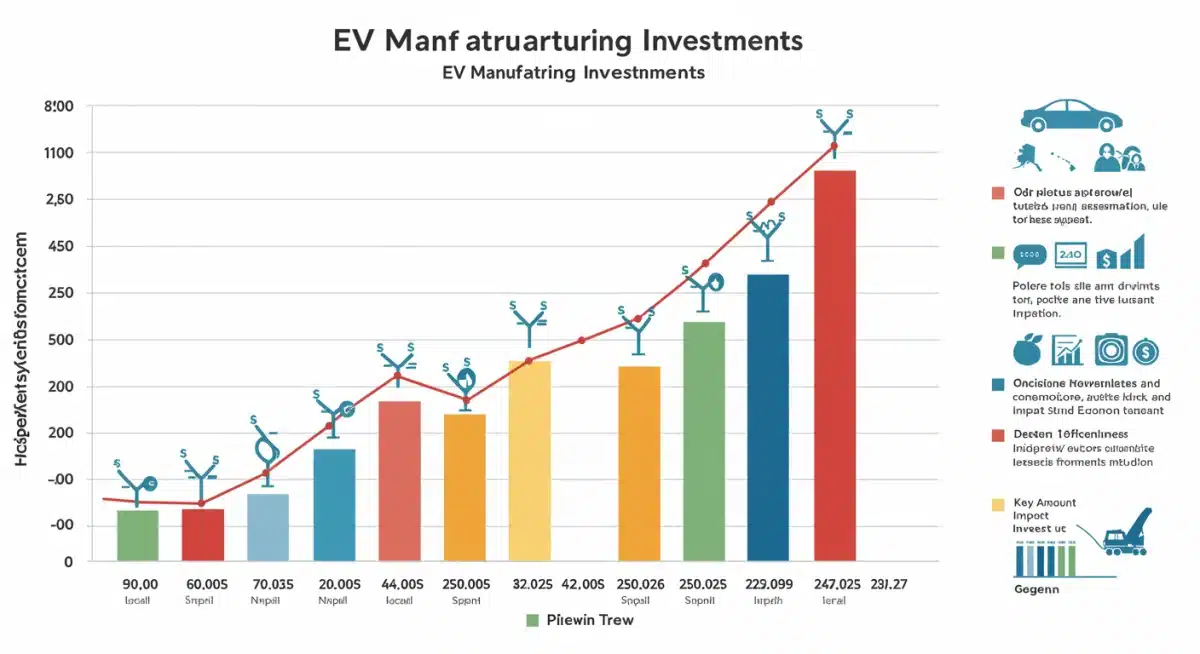
Charging Infrastructure Expansion and Accessibility
Beyond vehicle production, US government incentives are also accelerating the expansion of charging infrastructure, a crucial element for widespread EV adoption. The National Electric Vehicle Infrastructure (NEVI) Formula Program, part of the Bipartisan Infrastructure Law, is allocating billions to states to build a national network of EV chargers, especially along designated alternative fuel corridors. This initiative aims to address range anxiety and make EV ownership more practical for all Americans.
As of Q2 2025, significant progress is being made in deploying these chargers, with many states already having approved plans and begun construction. The focus is on high-powered DC fast chargers, ensuring efficient and convenient charging experiences. This infrastructure buildout is vital for supporting the growing number of EVs on the road and encouraging more consumers to make the switch.
State-Level Initiatives and Public-Private Partnerships
States are playing a crucial role in complementing federal efforts, often providing additional incentives for charging station deployment and promoting public-private partnerships. These collaborations are essential for accelerating the pace of infrastructure development and ensuring equitable access to charging facilities.
- Grants and Rebates: Many states offer grants or rebates for businesses and municipalities to install charging stations.
- Building Codes: Some states are implementing building codes that require new construction to be EV-ready, anticipating future demand.
- Utility Programs: Electric utilities are often involved through programs that support charger installation and grid upgrades.
Technological Advancement and Innovation
The competitive landscape fostered by government incentives is driving rapid technological advancement and innovation within the EV sector. Manufacturers are investing heavily in research and development to improve battery efficiency, extend range, reduce charging times, and enhance overall vehicle performance. This push for innovation is not only about meeting current market demands but also about staying ahead in a rapidly evolving industry.
New battery chemistries, advanced power electronics, and more efficient electric motors are continually emerging, promising even more compelling EV options for consumers. The focus on domestic production also encourages the development of new manufacturing techniques and automation, further solidifying the US’s position as a leader in automotive technology.
Consumer Adoption Trends and Market Dynamics
The combined effect of government incentives, expanding charging infrastructure, and improving EV technology is clearly influencing consumer adoption trends. Sales of electric vehicles continue to climb, albeit with some regional variations and market adjustments. As of Q2 2025, consumers are increasingly considering EVs due to lower operating costs, environmental benefits, and the growing array of available models.
However, challenges remain, including initial purchase price points for some segments and continued efforts needed to educate consumers on EV ownership. The incentives are designed to mitigate these barriers, making EVs more accessible and attractive to a broader demographic. Market data from Q2 2025 indicates a steady upward trajectory in EV market share, affirming the effectiveness of these government policies in stimulating demand.
Factors Influencing Consumer Choice
Several factors beyond direct incentives are shaping consumer decisions regarding EV purchases. These include evolving consumer preferences, the availability of diverse models, and the growing awareness of environmental impacts.
- Model Availability: An increasing variety of EV models, from sedans to SUVs and trucks, caters to diverse consumer needs and preferences.
- Environmental Awareness: Growing public concern over climate change is prompting more consumers to opt for zero-emission vehicles.
- Fuel Cost Savings: The economic advantage of charging an EV over fueling a gasoline car remains a significant draw for many buyers.
| Key Impact Area | Brief Description of Q2 2025 Impact |
|---|---|
| Domestic Production | Significant increase in US-based EV and battery manufacturing investments and facility expansions. |
| Supply Chain | Accelerated efforts to localize critical mineral sourcing and battery component production. |
| Charging Infrastructure | Continued expansion of the national EV charging network, aiding accessibility. |
| Consumer Adoption | Steady growth in EV sales and market share, driven by incentives and improved technology. |
Frequently Asked Questions About EV Incentives
The primary goal is to accelerate the transition to electric vehicles by stimulating domestic production, strengthening local supply chains, creating jobs, and making EVs more affordable and accessible for American consumers, ultimately reducing carbon emissions and reliance on fossil fuels.
Battery and critical mineral sourcing rules significantly impact which EV models qualify for federal tax credits. Manufacturers must source a percentage of battery components and critical minerals from North America or free-trade partners, driving a shift towards localized supply chains and influencing eligible vehicle lists.
Yes, consumer tax credits for new and used electric vehicles remain available in Q2 2025. However, eligibility criteria for both vehicles and buyers, including income limitations and sourcing requirements, are continually updated and must be met to claim the incentives.
The National Electric Vehicle Infrastructure (NEVI) program allocates significant federal funding to states to build out a national network of EV charging stations, particularly along major transportation corridors. Its role is crucial in addressing range anxiety and ensuring convenient charging access for EV owners across the country.
The incentives are directly stimulating substantial job growth in the US EV sector. Billions in investments for new manufacturing plants and battery facilities are creating thousands of jobs, from engineering and research to production and assembly, strengthening the American workforce and economy.
What Happens Next
Looking ahead, the trajectory set by US government incentives for EV production in Q2 2025 is expected to continue its profound influence. The focus will remain on solidifying domestic supply chains, particularly for critical minerals and battery components, as manufacturers strive for full compliance and maximum incentive utilization. Further expansion of charging infrastructure across rural and urban areas will be paramount to sustain the growth in EV adoption. Policymakers will likely monitor market dynamics closely, potentially adjusting incentive structures to address any emerging challenges or accelerate specific aspects of the EV transition, ensuring the US remains competitive in the global electric vehicle race.
